The Impacts of Rapid Urbanization on Farmland Marginalization: A Case Study of the Yangtze River Delta, China
Abstract
:1. Introduction
2. Data Sources and Research Methods
2.1. Research Framework
2.2. The Study Area
2.3. Data Source and Processing
2.4. Feature Selection
2.5. Research Methods
3. Results
3.1. Spatiotemporal Pattern of Farmland Marginalization in YRD from 2000 to 2020
3.1.1. Spatiotemporal Evolution Characteristics of Farmland Marginalization
3.1.2. Spatial Distribution Characteristics of Marginalized Farmland
3.2. The Influence of Different Factors on the Spatial Pattern of YRD Farmland Marginalization
3.2.1. Spatial Pattern of Farmland Marginalization in YRD under Different Factors
3.2.2. Spatial Differentiation Characteristics of Farmland Marginalization in YRD under Different Factors
3.3. The Main Driving Factors of Farmland Marginalization in YRD from 2000 to 2020
3.3.1. Spatial Autocorrelation Test and Model Selection
3.3.2. Spatial Econometric Model Results and Analysis
4. Discussion
4.1. General Trend of Farmland Marginalization in the Process of Rapid Urbanization
4.2. The Main Driving Factors of Farmland Marginalization in YRD
4.3. Limitations and Application of This Study
5. Conclusions
Author Contributions
Funding
Institutional Review Board Statement
Data Availability Statement
Conflicts of Interest
References
- Deng, X.; Huang, J.; Rozelle, S.; Uchida, E. Cultivated land conversion and potential agricultural productivity in China. Land Use Policy 2006, 23, 372–384. [Google Scholar] [CrossRef]
- Shi, T.; Li, X.; Xin, L.; Xu, X. The spatial distribution of farmland abandonment and its influential factors at the township level: A case study in the mountainous area of China. Land Use Policy Int. J. Cover. All Asp. Land Use 2018, 70, 510–520. [Google Scholar] [CrossRef]
- Alcantara, C.; Kuemmerle, T.; Prishchepov, A.V.; Radeloff, V.C. Mapping abandoned agriculture with multi-temporal MODIS satellite data. Remote Sens. Environ. 2012, 124, 334–347. [Google Scholar] [CrossRef]
- Renwick, A.; Jansson, T.; Verburg, P.H.; Revoredo-Giha, C.; Britz, W. Policy reform and agricultural land abandonment in the EU. Land Use Policy 2013, 30, 446–457. [Google Scholar] [CrossRef]
- Zhao, Y.L.; Zhang, M.; Li, X.B.; Dong, S.Z.; Huang, D.K. Farmland Marginalization and Policy Implications in Mountainous Areas: A Case Study of Renhuai City, Guizhou. J. Resour. Ecol. 2016, 7, 61–67. [Google Scholar]
- Swette, B.; Lambin, E.F. Institutional changes drive land use transitions on rangelands: The case of grazing on public lands in the American West. Glob. Environ. Change 2021, 66, 102220. [Google Scholar] [CrossRef]
- Stampini, M.; Davis, B. Does nonagricultural labor relax farmers’ credit constraints? Evidence from longitudinal data for Vietnam. Agric. Econ. 2009, 40, 177–188. [Google Scholar] [CrossRef]
- Martellozzo, F.; Amato, F.; Murgante, B.; Clarke, K.C. Modelling the impact of urban growth on agriculture and natural land in Italy to 2030. Appl. Geogr. 2018, 91, 156–167. [Google Scholar] [CrossRef] [Green Version]
- Wang, L.; Herzberger, A.; Zhang, L.; Xiao, Y.; Wang, Y.; Xiao, Y.; Liu, J.; Ouyang, Z. Spatial and Temporal Changes of Arable Land Driven by Urbanization and Ecological Restoration in China. Chin. Geogr. Sci. 2019, 29, 809–819. [Google Scholar] [CrossRef] [Green Version]
- Wang, Y. Population-land urbanization and comprehensive development evaluation of the Beijing-Tianjin-Hebei urban agglomeration. Env. Sci. Pollut. Res. Int. 2022, 4, 1–10. [Google Scholar] [CrossRef]
- Wang, Y. Effects of urbanization on spatial-temporal changes of cultivated land in Bohai Rim region. Environ. Dev. Sustain. 2022, 5, 1–18. [Google Scholar] [CrossRef]
- Yan, H.; Liu, J.; Huang, H.Q.; Tao, B.; Cao, M. Assessing the consequence of land use change on agricultural productivity in China. Glob. Planet. Change 2009, 67, 13–19. [Google Scholar] [CrossRef]
- Wu, Y.; Luo, J.; Zhang, X.; Skitmore, M. Urban growth dilemmas and solutions in China: Looking forward to 2030. Habitat Int. 2016, 56, 42–51. [Google Scholar] [CrossRef] [Green Version]
- Li, H.; Huang, X.; Kwan, M.P.; Bao, H.X.H.; Jefferson, S. Changes in farmers’ welfare from land requisition in the process of rapid urbanization. Land Use Policy 2015, 42, 635–641. [Google Scholar] [CrossRef] [Green Version]
- Li, H.; Wu, Y.; Huang, X.; Sloan, M.; Skitmore, M. Spatial-temporal evolution and classification of marginalization of cultivated land in the process of urbanization. Habitat Int. 2017, 61, 1–8. [Google Scholar] [CrossRef] [Green Version]
- Zhang, R.; Li, P.; Xu, L.; Zhong, S.; Wei, H. An integrated accounting system of quantity, quality and value for assessing cultivated land resource assets: A case study in Xinjiang, China. Glob. Ecol. Conserv. 2022, 36, e02115. [Google Scholar] [CrossRef]
- Shao, J.A.; Zhang, S.; Li, X. Farmland marginalization in the mountainous areas: Characteristics, influencing factors and policy implications. J. Geogr. Sci. 2015, 25, 701–722. [Google Scholar] [CrossRef]
- Macdonald, D.; Crabtree, J.R.; Wiesinger, G.; Dax, T.; Stamou, N.; Fleury, P.; Lazpita, J.G.; Gibon, A. Agricultural abandonment in mountain areas of Europe: Environmental consequences and policy response. J. Environ. Manag. 2000, 59, 47–69. [Google Scholar] [CrossRef]
- Strijker, D. Marginal lands in Europe—Causes of decline. Basic Appl. Ecol. 2005, 6, 99–106. [Google Scholar] [CrossRef]
- Li, Y.; Zhou, T.; Jiang, G.; Li, G.; Zhou, D.; Luo, Y. Spatial pattern and mechanisms of farmland abandonment in Agricultural and Pastoral Areas of Qingzang Plateau. Geogr. Sustain. 2021, 2, 139–150. [Google Scholar] [CrossRef]
- He, Y.; Xie, H.; Peng, C. Analyzing the behavioural mechanism of farmland abandonment in the hilly mountainous areas in China from the perspective of farming household diversity. Land Use Policy 2020, 99, 104826. [Google Scholar] [CrossRef]
- Ma, L.; Long, H.; Tu, S.; Zhang, Y.; Zheng, Y. Farmland transition in China and its policy implications. Land Use Policy 2020, 92, 104470. [Google Scholar] [CrossRef]
- Ying, L.; Chunshan, Z.; Wanling, H.; Qianqiong, Z. Spatial features and forming mechanism of rural land non-agricultural degree in metropolitan areas: A case study of Guangzhou City. Prog. Geogr. 2018, 37, 1119–1130. [Google Scholar]
- Prishchepov, A.V.; Radeloff, V.C.; Baumann, M.; Kuemmerle, T.; Muller, D. Effects of institutional changes on land use: Agricultural land abandonment during the transition from state-command to market-driven economies in post-Soviet Eastern Europe. Environ. Res. Lett. 2012, 7, 024021. [Google Scholar] [CrossRef]
- Tan, Y.; Chen, H.; Xiao, W.; Meng, F.; He, T. Influence of farmland marginalization in mountainous and hilly areas on land use changes at the county level. Sci. Total Environ. 2021, 794, 149576. [Google Scholar] [CrossRef]
- Van, D.; Verburg, P.H.; Schulp, C.; Verkerk, P.J. Trade-offs of European agricultural abandonment. Land Use Policy 2017, 62, 290–301. [Google Scholar]
- Mantero, G.; Morresi, D.; Marzano, R.; Motta, R.; Mladenoff, D.J.; Garbarino, M. The influence of land abandonment on forest disturbance regimes: A global review. Landsc. Ecol. 2020, 35, 2723–2744. [Google Scholar] [CrossRef]
- Wang, Y.; Li, X.; Xin, L.; Tan, M. Farmland marginalization and its drivers in mountainous areas of China. Sci. Total Environ. 2019, 719, 135132. [Google Scholar] [CrossRef]
- Lu, Z.L.; Pan, X.C.; Zhou, G.L.; Tang, Z.T.; Li, X.C.; Guo, Y.J.; Huang, J.T.; Zhuang, D.C. Study on the Characteristics and Influencing Factors of Farmland Marginalization in Suburban Rural Areas of Metropolis: A Survey of Rural Households in Suburban Areas of Guangzhou City. China Land Sci. 2021, 35, 67–74. [Google Scholar]
- Hua, X.B.; Yan, J.Z.; Zhou, C.J.; Chen, L. Marginalization of Agricultural Land Use in Hilly Areas and Its Explanation from the Livelihood Strategy of Farmers: A Case Study on Youyang County. Acta Sci. Nat. Univ. Pekin. 2013, 49, 0479–8023. [Google Scholar]
- Wang, Y.H.; Xin, L.J.; Zhang, H.Z.; Li, Y.Q. An Estimation of the Extent of Rent-Free Farmland Transfer and Its Driving Forces in Rural China: A Multilevel Logit Model Analysis. Sustainability 2019, 11, 3161. [Google Scholar] [CrossRef] [Green Version]
- Liu, Y.; Wang, J.; Long, H. Analysis of arable land loss and its impact on rural sustainability in Southern Jiangsu Province of China. J. Environ. Manag. 2010, 91, 646–653. [Google Scholar] [CrossRef] [PubMed]
- Zhang, J.; Zhang, F.; Zhang, D.; He, D.; Zhang, L.; Wu, C.; Kong, X. The grain potential of cultivated lands in Mainland China in 2004. Land Use Policy 2009, 26, 68–76. [Google Scholar] [CrossRef]
- Lu, H.; Chen, Y.; Huan, H.; Duan, N. Analyzing Cultivated Land Protection Behavior From the Perspective of Land Fragmentation and Farmland Transfer: Evidence From Farmers in Rural China. Front. Environ. Sci. 2022, 10, 901097. [Google Scholar] [CrossRef]
- Mawois, M.; Aubry, C.; Bail, M.L. Can farmers extend their cultivation areas in urban agriculture? A contribution from agronomic analysis of market gardening systems around Mahajanga (Madagascar). Land Use Policy 2011, 28, 434–445. [Google Scholar] [CrossRef]
- Xiao, R. The Impacts of Farmland Loss on Regional Food Self-Sufficiency in Yangtze River Delta Urban Agglomeration over Last Two Decades. Remote Sens. 2021, 13, 3514. [Google Scholar]
- Lichtenberg, E.; Ding, C. Assessing farmland protection policy in China. Land Use Policy 2008, 25, 59–68. [Google Scholar] [CrossRef]
- Zhang, M.; Chen, Q.; Zhang, K. Influence of the variation in rural population on farmland preservation in the rapid urbanization area of China. J. Geogr. Sci. 2021, 31, 1365–1380. [Google Scholar] [CrossRef]
- Song, W.; Wu, K.; Zhao, H.; Zhao, R.; Li, T. Arrangement of High-standard Basic Farmland Construction Based on Village-region Cultivated Land Quality Uniformity. Chin. Geogr. Sci. 2018, 29, 325–340. [Google Scholar] [CrossRef] [Green Version]
- Chen, F.; Liu, J.N.; Chang, Y.Y.; Zhang, Q.; Yu, H.C.; Zhang, S.L. Spatial Pattern Differentiation of Non-grain Cultivated Land and Its Driving Factors in China. China Land Sci. 2021, 35, 33–43. [Google Scholar]
- Lu, Q.; Soderlud, L.; Wu, P.L.; Li, J. Cultivated land loss arising from the rapid urbanization in China. Agrifood Res. Rep. 2005, 68, 313–327. [Google Scholar]
- Hu, Y.; Wang, X.L. Analysis on the Change of Land Use Structure and Its Driving Factors in Wuhan City. Res. Soil Water Conserv. 2014, 21, 234–239. [Google Scholar]
- Huang, H.; Zhou, Y.; Qian, M.; Zeng, Z. Land Use Transition and Driving Forces in Chinese Loess Plateau: A Case Study from Pu County, Shanxi Province. Land 2021, 10, 67. [Google Scholar] [CrossRef]
- Zhan, J.Y.; Shi, N.N.; He, S.J.; Lin, Y.Z. Factors and mechanism driving the land-use conversion in Jiangxi Province. J. Geogr. Sci. 2010, 20, 525–539. [Google Scholar] [CrossRef]
- Xie, H.; Lu, H. Impact of land fragmentation and non-agricultural labor supply on circulation of agricultural land management rights. Land Use Policy 2017, 68, 355–364. [Google Scholar] [CrossRef]
- Viaggi, D.; Signorotti, C.; Marconi, V.; Raggi, M. Do agri-environmental schemes contribute to high nature value farmland? A case study in Emilia-Romagna (Italy). Ecol. Indic. 2015, 59, 62–69. [Google Scholar] [CrossRef]
- Getis, A.; Ord, J.K. The Analysis of Spatial Association by Use of Distance Statistics. Geogr. Anal. 1992, 24, 189–206. [Google Scholar] [CrossRef]
- Das, M.; Ghosh, S.K. Measuring Moran’s I in a Cost-Efficient Manner to Describe a Land-Cover Change Pattern in Large-Scale Remote Sensing Imagery. IEEE J. Sel. Top. Appl. Earth Obs. Remote Sens. 2017, 10, 2631–2639. [Google Scholar] [CrossRef]
- Yang, F.; Liu, G.; Cheikhrouhou, O. Research on Spillover Effect of Urbanization on Rural Land Transfer Based on the SDM Model of Intelligent Computing. Mob. Inf. Syst. 2022, 2022, 1–10. [Google Scholar] [CrossRef]
- Li, Y.R.; Liu, Y.S.; Long, H.L.; Cui, W.G. Community-based rural residential land consolidation and allocation can help to revitalize hollowed villages in traditional agricultural areas of China: Evidence from Dancheng County, Henan Province. Land Use Policy 2014, 39, 188–198. [Google Scholar] [CrossRef]
- Long, H.; Li, Y.; Liu, Y.; Woods, M.; Jian, Z. Accelerated restructuring in rural China fueled by ‘increasing vs. decreasing balance’ land-use policy for dealing with hollowed villages. Land Use Policy 2012, 29, 11–22. [Google Scholar] [CrossRef]
- Zhang, R.J.; Jiang, G.H.; Zhang, Q. Does urbanization always lead to rural hollowing? Assessing the spatio-temporal variations in this relationship at the county level in China 2000e2015. J. Clean. Prod. 2019, 220, 9–22. [Google Scholar] [CrossRef]
- Shi, T.; Li, X.; Xin, L.; Xu, X. Analysis of Farmland Abandonment at Parcel Level: A Case Study in the Mountainous Area of China. Sustainability 2016, 8, 988. [Google Scholar] [CrossRef] [Green Version]
- Xiao, M.; Zhang, Q.; Qu, L.; Hussain, H.; Dong, Y.; Zheng, L. Spatiotemporal Changes and the Driving Forces of Sloping Farmland Areas in the Sichuan Region. Sustainability 2019, 11, 906. [Google Scholar] [CrossRef] [Green Version]
- Cao, Y.G.; Yuan, C.; Zhou, W.; Jin, T.; Rong, H. Analysis on Driving Forces and Provincial Differences of Cultivated Land Change in China. China Land Sci. 2008, 22, 17–22. [Google Scholar]
- Qian, F.K.; Chi, Y.R.; Lal, R. Spatiotemporal characteristics analysis of multifunctional cultivated land: A case study in Shenyang, Northeast China. Land Degrad. Dev. 2020, 31, 1812–1822. [Google Scholar] [CrossRef]
- Burra, D.D.; Parker, L.; Than, N.T.; Phengsavanh, P.; Nam, V. Drivers of land use complexity along an agricultural transition gradient in Southeast Asia. Ecol. Indic. 2021, 124, 107402. [Google Scholar] [CrossRef]
- Khanal, N.R.; Watanabe, T. Abandonment of Agricultural Land and Its Consequences. Mt. Res. Dev. 2006, 26, 32–40. [Google Scholar] [CrossRef] [Green Version]
- Sun, L.; Yan, J.; Yang, Z.; Li, Z.; Xin, L. Drivers of cropland abandonment in mountainous areas: A household decision model on farming scale in Southwest China. Land Use Policy 2016, 57, 459–469. [Google Scholar]
- Abdollahzadeh, G.; Azadi, H.; Sharifzadeh, M.S.; Jahangir, L.; Janeková, K.; Sklenika, P.; Tan, R.; Witlox, F. Landholders’ perception of conversion of steep lands to orchard schemes: Land use policy implications in North Iran. Land Use Policy 2021, 102, 105205. [Google Scholar] [CrossRef]
- Li, S.; Li, X. The mechanism of farmland marginalization in Chinese mountainous areas: Evidence from cost and return changes. J. Geogr. Sci. 2019, 29, 531–548. [Google Scholar] [CrossRef] [Green Version]
- Yu, M.; Yang, Y.; Chen, F.; Zhu, F.; Qu, J.; Zhang, S. Response of agricultural multifunctionality to farmland loss under rapidly urbanizing processes in Yangtze River Delta, China. Sci. Total Environ. 2019, 666, 1–11. [Google Scholar] [CrossRef] [PubMed]
- Song, W. Decoupling cultivated land loss by construction occupation from economic growth in Beijing. Habitat Int. 2014, 43, 198–205. [Google Scholar] [CrossRef]




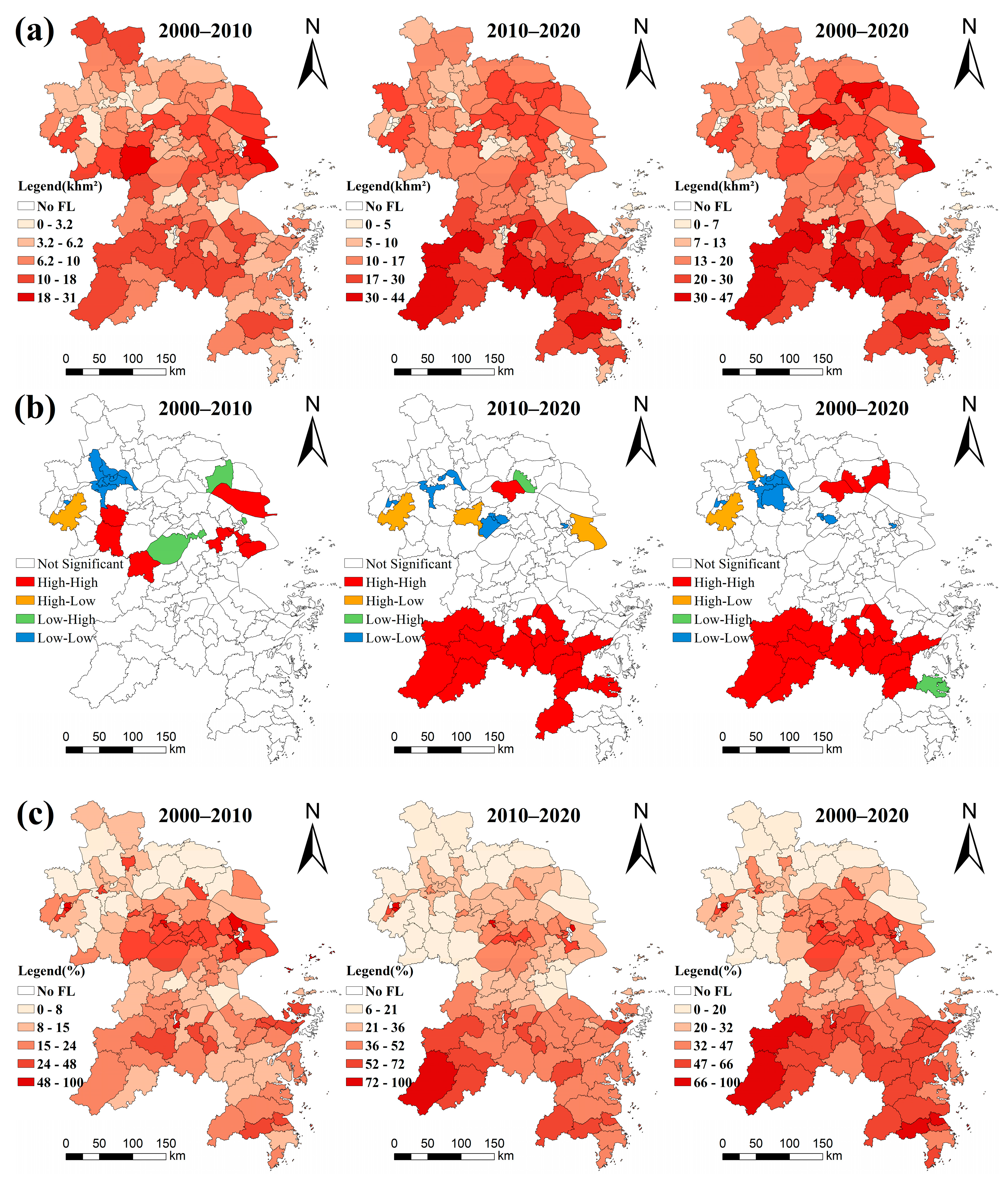
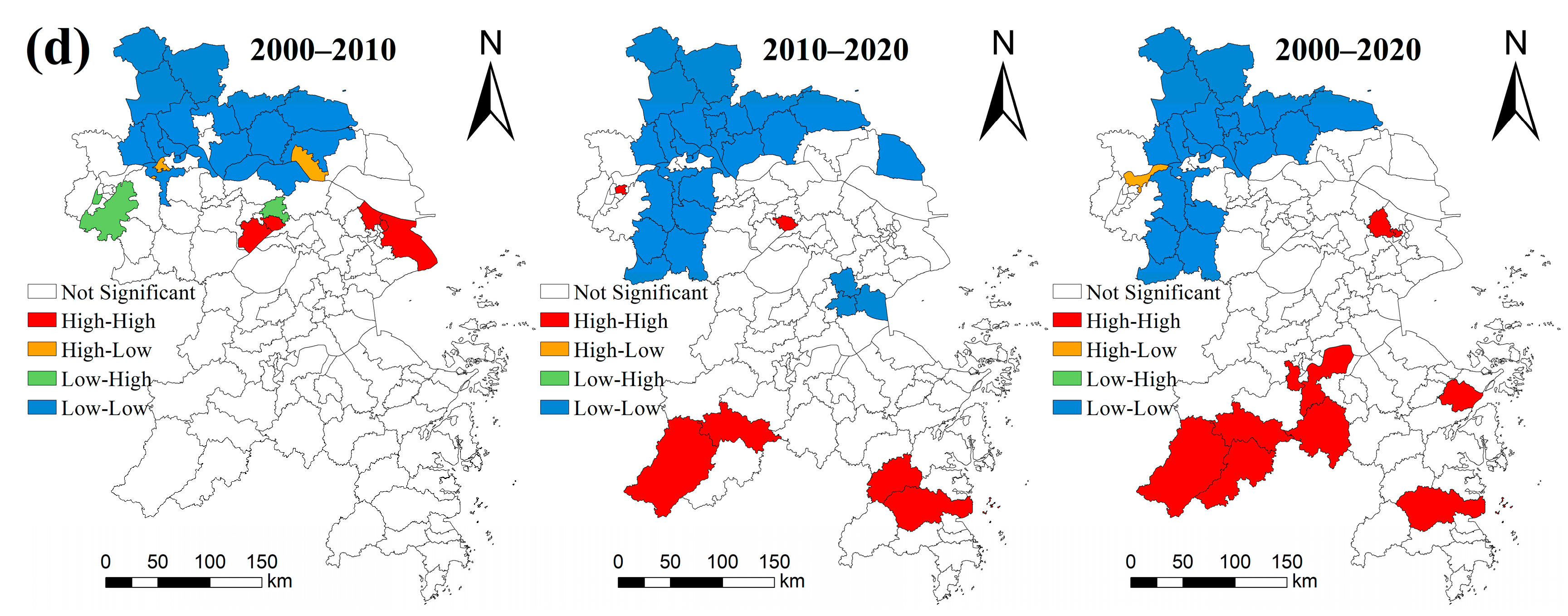
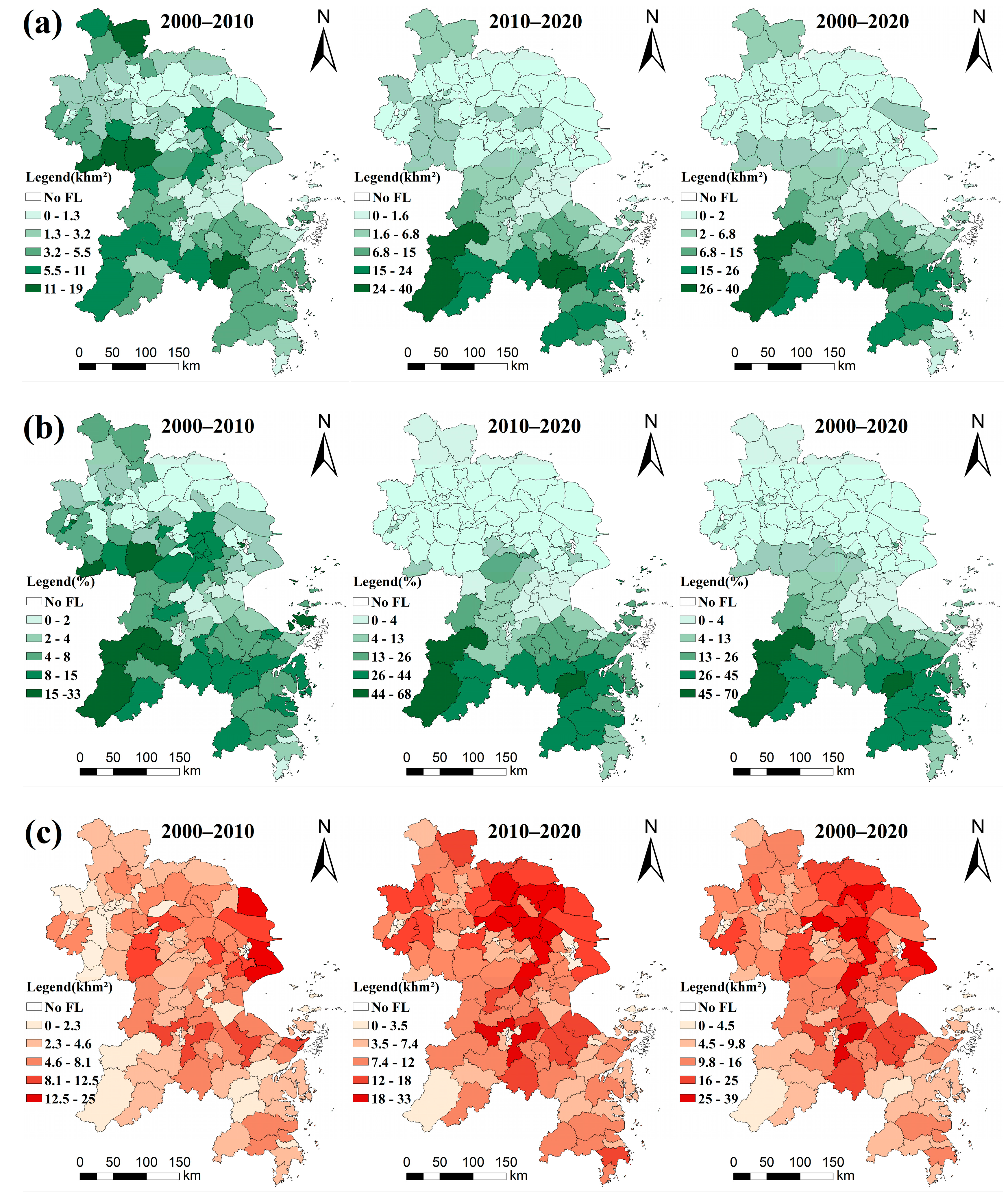
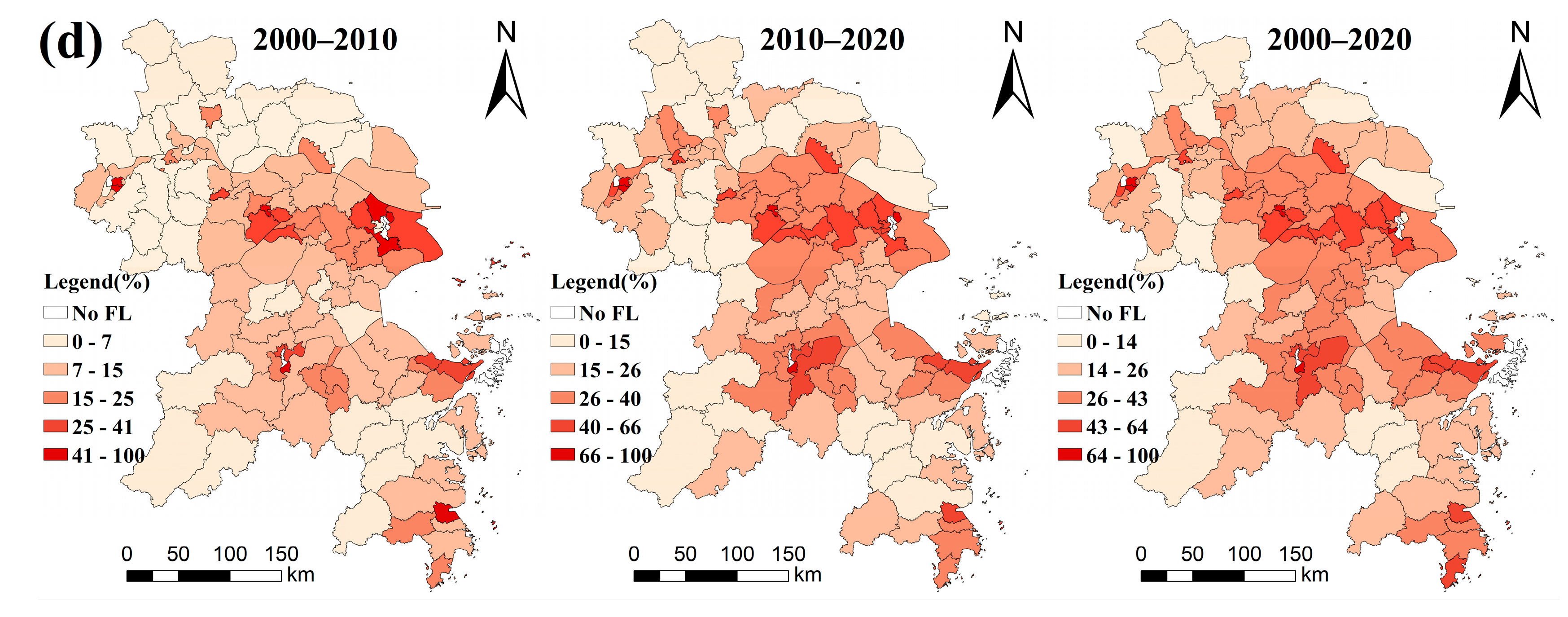

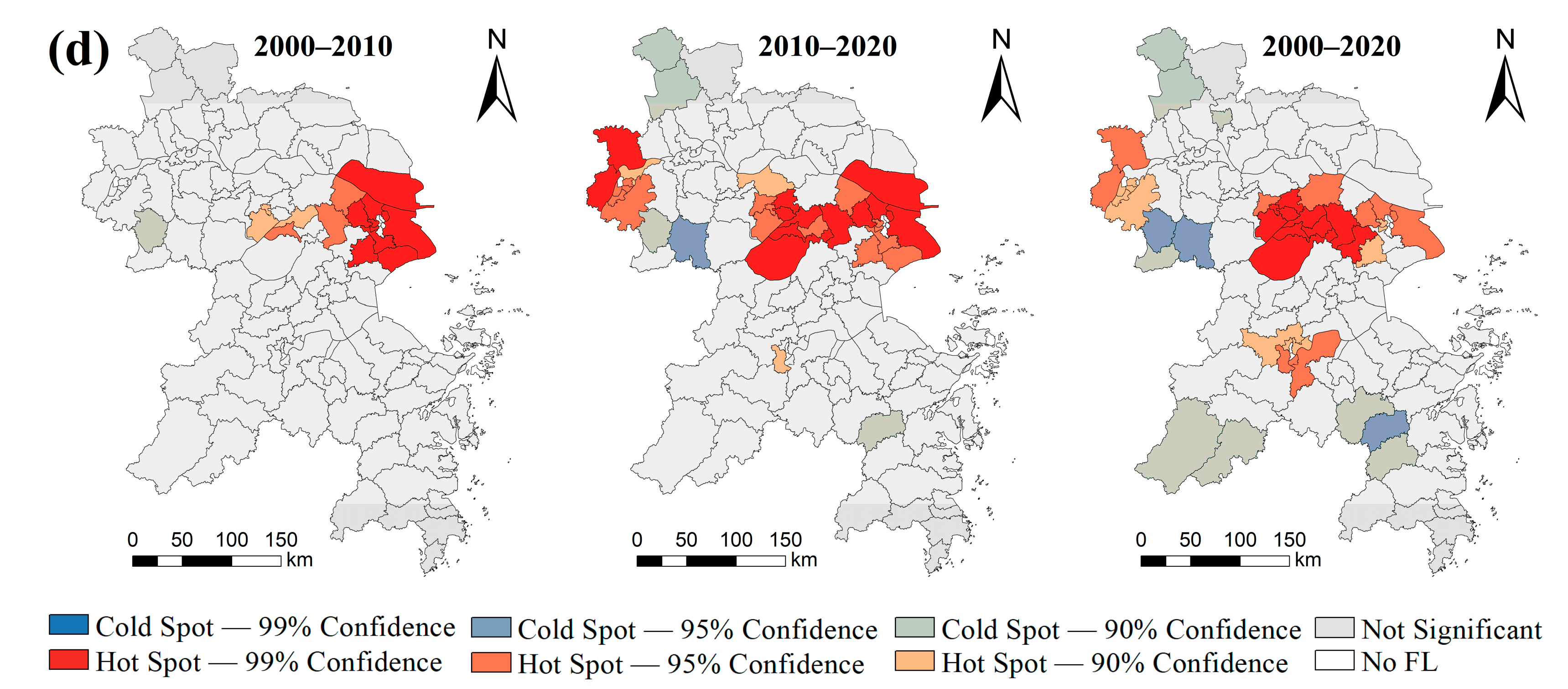
| Data Type | Index | Year | Resolution or Unit | Data Sources |
|---|---|---|---|---|
| Socioeconomic data | farmland per capita, total power of agricultural machinery, small agricultural machinery, urbanization ratio, GDP per capita, income of rural residents, government farmland subsidies | 2020 | County unit | The statistical yearbooks in Jiangsu Province, Zhejiang Province, and Shanghai in 2020 |
| Remote sensing image | GlobeLand30, average area of farmland patch | 2000/2010/2020 | 30 m | The Aerospace Information Research Institute (AIR), CAS (http://www.aircas.cas.cn/) (accessed on 16 March 2022) |
| Vector data | China’s county-level administrative boundaries, land use remote sensing monitoring data | 2015 | County unit | Resource and Environment Science and Data Center (https://www.resdc.cn/) (accessed on 18 March 2022) |
| Natural environment data | Elevation, slope | 2020 | 30 m | The National Aeronautics and Space Administration (https://www.nasa.gov/) (accessed on 18 March 2022) |
| Type | Dimension | Independent Variables | Expected Symbol | References |
|---|---|---|---|---|
| Socioeconomic | Production conditions | Farmland area per capita (x1) | − | [39] |
| Total power of agricultural machinery (x2) | − | [40] | ||
| Small agricultural machinery (x3) | − | [17] | ||
| Economic level | Urbanization ratio (x4) | ± | [41] | |
| GDP per capita (x5) | − | [42] | ||
| Income of rural residents (x6) | + | [43] | ||
| Government farmland subsidies (x7) | − | [29] | ||
| Natural conditions | Terrain conditions | Elevation (x8) | + | [17,44] |
| Slope (x9) | + | [32] | ||
| Average lot area (x10) | − | [45] |
| Inspection Methods | Farmland Marginalization | Nature-Induced Marginalization | Economy-Induced Marginalization | |||
|---|---|---|---|---|---|---|
| Statistic | p | Statistic | p | Statistic | p | |
| Residual Moran’s I | 1.125 | 0.261 | 0.890 | 0.373 | 1.104 | 0.270 |
| Spatial error LM | 2.220 | 0.136 | 0.193 | 0.660 | 1.942 | 0.163 |
| Spatial error R-LM | 0.381 | 0.537 | 1.620 | 0.203 | 0.366 | 0.545 |
| Spatial lag LM | 16.392 | 0.000 | 9.006 | 0.003 | 15.326 | 0.000 |
| Spatial lag R-LM | 14.553 | 0.000 | 10.433 | 0.001 | 13.750 | 0.000 |
| Explanatory Variables | Farmland Marginalization | Nature-Induced Marginalization | Economy-Induced Marginalization | |||
|---|---|---|---|---|---|---|
| OLS | SLM | OLS | SLM | OLS | SLM | |
| x1 | −0.562 * | −0.598 ** | 0.529 | 0.413 | −0.657 ** | −0.689 *** |
| (0.059) | (0.022) | (0.339) | (0.410) | (0.015) | (0.004) | |
| x2 | −0.197 *** | −0.252 *** | 0.419 | 0.314 | 0.217 | 0.134 |
| (0.001) | (0.002) | (0.104) | (0.181) | (0.083) | (0.233) | |
| x3 | −0.301 | −0.107 | 0.172 | 0.075 | 0.339 *** | 0.298 *** |
| (0.152) | (0.386) | (0.315) | (0.634) | (0.000) | (0.000) | |
| x4 | 0.878 | 1.453 * | −2.807 * | −3.054 ** | −0.152 | 0.706 *** |
| (0.296) | (0.053) | (0.075) | (0.032) | (0.842) | (0.005) | |
| x5 | −0.683 * | −0.663 ** | −1.366 * | −1.285 ** | −0.449 | −0.442 |
| (0.074) | (0.048) | (0.056) | (0.046) | (0.194) | (0.148) | |
| x6 | 1.071 | 0.434 | 4.351 *** | 3.118 ** | 1.298 * | 0.721 |
| (0.209) | (0.571) | (0.007) | (0.036) | (0.094) | (0.302) | |
| x7 | −0.224 | −0.234 ** | 0.373 | 0.396 | −0.132 | −0.149 |
| (0.369) | (0.026) | (0.423) | (0.348) | (0.557) | (0.457) | |
| x8 | 0.148 | 0.064 | −0.443 * | −0.456 ** | 0.223 | 0.137 |
| (0.272) | (0.591) | (0.079) | (0.045) | (0.169) | (0.212) | |
| x9 | −0.601 | 0.112 | 1.985 *** | 1.924 *** | −0.332 | −0.149 |
| (0.836) | (0.668) | (0.000) | (0.000) | (0.212) | (0.532) | |
| x10 | 0.263 * | −0.252 * | 0.382 | 0.406 | 0.343 ** | −0.327 *** |
| (0.081) | (0.056) | (0.173) | (0.109) | (0.012) | (0.007) | |
| ρ | 0.026 *** | 0.052 *** | 0.232 *** | |||
| (0.000) | (0.001) | (0.000) | ||||
| Adj.R2 | 0.372 | 0.639 | 0.458 | 0.783 | 0.389 | 0.731 |
| Log L | −193.678 | −179.299 | −301.259 | −257.568 | −184.372 | −168.194 |
| AIC | 398.129 | 384.599 | 548.249 | 541.135 | 374.721 | 362.387 |
Publisher’s Note: MDPI stays neutral with regard to jurisdictional claims in published maps and institutional affiliations. |
© 2022 by the authors. Licensee MDPI, Basel, Switzerland. This article is an open access article distributed under the terms and conditions of the Creative Commons Attribution (CC BY) license (https://creativecommons.org/licenses/by/4.0/).
Share and Cite
Liu, J.; Zeng, S.; Ma, J.; Chang, Y.; Sun, Y.; Chen, F. The Impacts of Rapid Urbanization on Farmland Marginalization: A Case Study of the Yangtze River Delta, China. Agriculture 2022, 12, 1276. https://doi.org/10.3390/agriculture12081276
Liu J, Zeng S, Ma J, Chang Y, Sun Y, Chen F. The Impacts of Rapid Urbanization on Farmland Marginalization: A Case Study of the Yangtze River Delta, China. Agriculture. 2022; 12(8):1276. https://doi.org/10.3390/agriculture12081276
Chicago/Turabian StyleLiu, Junna, Siyan Zeng, Jing Ma, Yuanyuan Chang, Yan Sun, and Fu Chen. 2022. "The Impacts of Rapid Urbanization on Farmland Marginalization: A Case Study of the Yangtze River Delta, China" Agriculture 12, no. 8: 1276. https://doi.org/10.3390/agriculture12081276
APA StyleLiu, J., Zeng, S., Ma, J., Chang, Y., Sun, Y., & Chen, F. (2022). The Impacts of Rapid Urbanization on Farmland Marginalization: A Case Study of the Yangtze River Delta, China. Agriculture, 12(8), 1276. https://doi.org/10.3390/agriculture12081276






